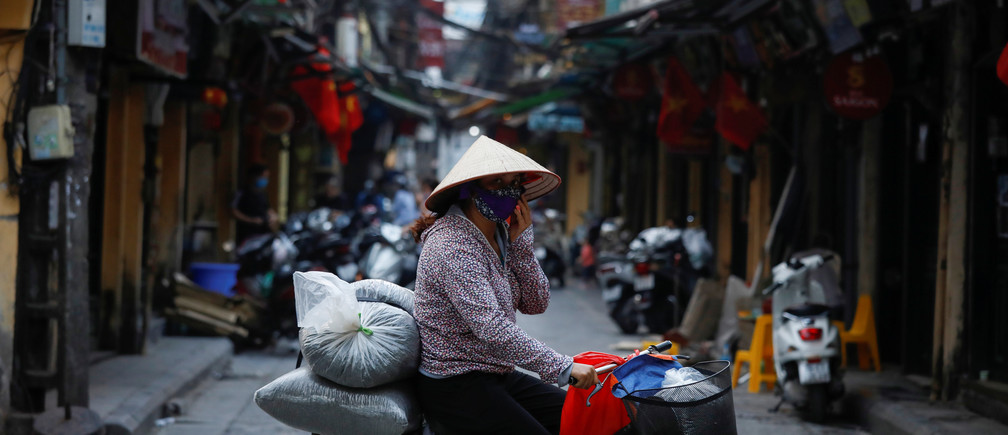Viet Nam shows how you can contain COVID-19 with limited resources

Vietnam's anti-coronavirus measures include mandatory 14-day quarantines for anyone arriving in Vietnam. Image: REUTERS/Kham - RC2QRF9U80MC

Explore and monitor how COVID-19 is affecting economies, industries and global issues

Get involved with our crowdsourced digital platform to deliver impact at scale
Stay up to date:
COVID-19
- To date, Viet Nam has had no fatalities as a result of the pandemic.
- The government acted swiftly to suspend flights, shut schools and quarantine new arrivals.
- More than 45 million Vietnamese have been lifted out of poverty between 2002 and 2018.
How does a nation with limited resources confront a global pandemic that has brought many developed countries’ healthcare systems to a breaking point?
That’s the challenge facing many of the world’s poorer, developing nations - including countries like Viet Nam. But while it might look like a foregone conclusion that the coronavirus outbreak would ravage such a country, Viet Nam has instead stood out as a beacon of how to do more with less.
So far, the country has 194 confirmed COVID-19 coronavirus cases, and no fatalities. Unlike other, wealthier Asian countries, Viet Nam isn’t in a position to conduct mass testing programmes. South Korea, for example, has tested 338,000 people. In Viet Nam, that number stands at just 15,637 people (figures for 20 March 2020). But by focusing on measures that are within its control, the country has won praise from the international community.
Swift action
On 1 February, Viet Nam kicked off a series of initiatives to tackle the spread of COVID-19. It suspended all flights to and from China. It also decided to keep schools closed after the lunar New Year break. Two weeks later, a 21-day quarantine was imposed in Vinh Phuc province, north of Hanoi. That decision was sparked by concerns over the health status of migrant workers returning from Wuhan, China, where the virus originated.
Viet Nam's proactive efforts come after two decades in which the country has experienced a large improvement in quality of life. Between 2002 and 2018, an economic transformation helped to lift more than 45 million Vietnamese out of poverty. Gross domestic product (GDP) per capita has more than doubled, to over $2,500 in 2018, when the country saw real GDP growth of 7.1%. The health of the nation has improved, too – life expectancy rose from 71 years in 1990 to 76 years in 2015.

The country’s healthcare system is improving, too, but still has a lot of ground to cover. There are around eight doctors to every 10,000 people in Viet Nam. Italy and Spain both have 41 doctors per 10,000 people, the US has 26, and China 18.
Its anti-coronavirus measures have gone on to include mandatory 14-day quarantines for anyone arriving in Viet Nam and the cancellation of all foreign flights. It has also isolated infected people and then set about tracking down anyone they might have come into contact with.
“Neighbours know if you come from a foreign country,” said Truong Huu Khanh, head of the department of infectious diseases at Ho Chi Minh City Children’s hospital. “If an infected person is in the area, they will report this.”
What is the World Economic Forum doing about the coronavirus outbreak?
Neighbourhood watch
As a single-party state, with large and well-organized military and security services, Viet Nam has been able to make decisions quickly and enact them promptly. There is also a strong culture of surveillance, with people expected to inform on their neighbours if they suspect any wrong-doing. Anyone found sharing fake news and misinformation about the coronavirus risks a visit from the police, and around 800 people have been fined so far.
It’s not the kind of approach that is likely to work in more open societies. But with limited clinical resources at its disposal, Viet Nam has seemingly managed to get the outbreak under control.
Meanwhile, nearby Thailand has so far recorded four COVID-19 deaths, but is experiencing a significant rise in infections. On 24 March, Thailand’s Public Health Ministry announced 107 new cases, bringing the total to 934. The fault, according to Dr Taweesin Visanuyothin of the ministry, lies with “partygoers (who) transmitted the disease to about 100 other people … at-risk people must obey social distancing, both at their workplaces and at home.”
Another close neighbour, Myanmar, is drawing criticism from some for what has been perceived as a lack of transparency over the outbreak. Aung San Suu Kyi, Myanmar’s civilian leader, claimed recently the country had no cases of COVID-19, although that figure now stands at three.
The government has made claims that “lifestyle and diet”, along with people’s preference for cash instead of credit cards, was keeping Myanmar safe from the illness. These and other similar statements drew the ire of Phil Robertson, Deputy Director, Asia Division of Human Rights Watch, who said: “Such irresponsible statements clash with everything known about the coronavirus outbreak, defy reality, and only serve to give a false sense of security to the country’s people about the disease and their risks of infection.”
Don't miss any update on this topic
Create a free account and access your personalized content collection with our latest publications and analyses.
License and Republishing
World Economic Forum articles may be republished in accordance with the Creative Commons Attribution-NonCommercial-NoDerivatives 4.0 International Public License, and in accordance with our Terms of Use.
The views expressed in this article are those of the author alone and not the World Economic Forum.
Related topics:
The Agenda Weekly
A weekly update of the most important issues driving the global agenda
You can unsubscribe at any time using the link in our emails. For more details, review our privacy policy.
More on COVID-19See all
Charlotte Edmond
January 8, 2024
Charlotte Edmond
October 11, 2023
Douglas Broom
August 8, 2023
Simon Nicholas Williams
May 9, 2023
Philip Clarke, Jack Pollard and Mara Violato
April 17, 2023





